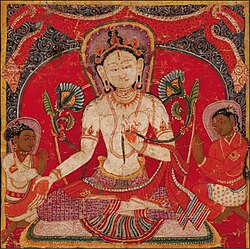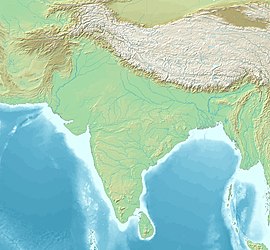
Back Royaume khasa French खस राज्य Hindi Regno Khasa Italian खस राज्य Nepali Khasa-riket NB கச மல்ல இராச்சியம் Tamil 亚泽王朝 Chinese
Khasa Malla Kingdom खस मल्ल राज्य (Nepali) | |||||||||||||||||
|---|---|---|---|---|---|---|---|---|---|---|---|---|---|---|---|---|---|
| 11th–14th centuries | |||||||||||||||||
 Painting of Khasa Buddhist King Ripu Malla and his son Sangrama worshiping the Goddess Tara (center) c. 1312 | |||||||||||||||||
Location of the Sinja Valley, heartland of the Khasa Kingdom, and location of known inscriptions. | |||||||||||||||||
| Capital | Sinja Valley | ||||||||||||||||
| Common languages | |||||||||||||||||
| Religion | |||||||||||||||||
| Government | Monarchy | ||||||||||||||||
| Maharajadhiraja[1] (Sovereign King) | |||||||||||||||||
• c. 11th century | Nāgarāja | ||||||||||||||||
• 1207-1223 | Krachalla Deva | ||||||||||||||||
• 1223–1287 | Ashok Challa | ||||||||||||||||
• | Jitari Malla | ||||||||||||||||
• | Ananda Malla | ||||||||||||||||
• early 14th century | Ripu Malla | ||||||||||||||||
• 14th century | Punya Malla | ||||||||||||||||
• 14th century | Prithvi Malla | ||||||||||||||||
• 14th century | Abhaya Malla | ||||||||||||||||
| History | |||||||||||||||||
• Established | 11th | ||||||||||||||||
• Disestablished | 14th centuries | ||||||||||||||||
| |||||||||||||||||
| Today part of | |||||||||||||||||
Khasa-Malla kingdom (Nepali: खस मल्ल राज्य, romanized: Khasa Malla Rājya), popularly known as Khasa Kingdom (Nepali: खस राज्य, romanized: Khasa Rājya) and Yatse (Wylie: ya rtse) in Tibetan, was a medieval kingdom established around the 11th century in regions that are presently in far-western Nepal and parts of Uttarakhand state in India.
The origins of the ruling family are disputed with some arguing that the kingdom was ruled by kings of Khasa tribe who bore the family name "Malla" (not to be confused with the later Malla dynasty of Kathmandu).[2] However a growing body of evidence indicates that the ruling family were descended from the Tibetan House of Yatse and was gradually Indianised.[3] The Khasa Malla kings ruled western parts of Nepal during 11th–14th century.[4] The 954 AD Khajuraho Inscription of Dhaṇga states that the Khasa Kingdom were equivalent to the Gaudas of Bengal and the Gurjara-Pratihara dynasty.[5]
- ^ Gnyawali 1971, p. 266.
- ^ Adhikary 1997, p. 37.
- ^ Grimes, Samuel (2023). "What's in a Name? Reflections on the Tibetan Yatse Dynasty and Nepal's Role in Its Transition to the Indic ('Khas') Malla Dynasty". The Medieval History Journal.
- ^ Krishna P. Bhattarai (1 January 2009). Nepal. Infobase Publishing. p. 113. ISBN 978-1-4381-0523-9.
- ^ Thakur 1990, p. 287.
